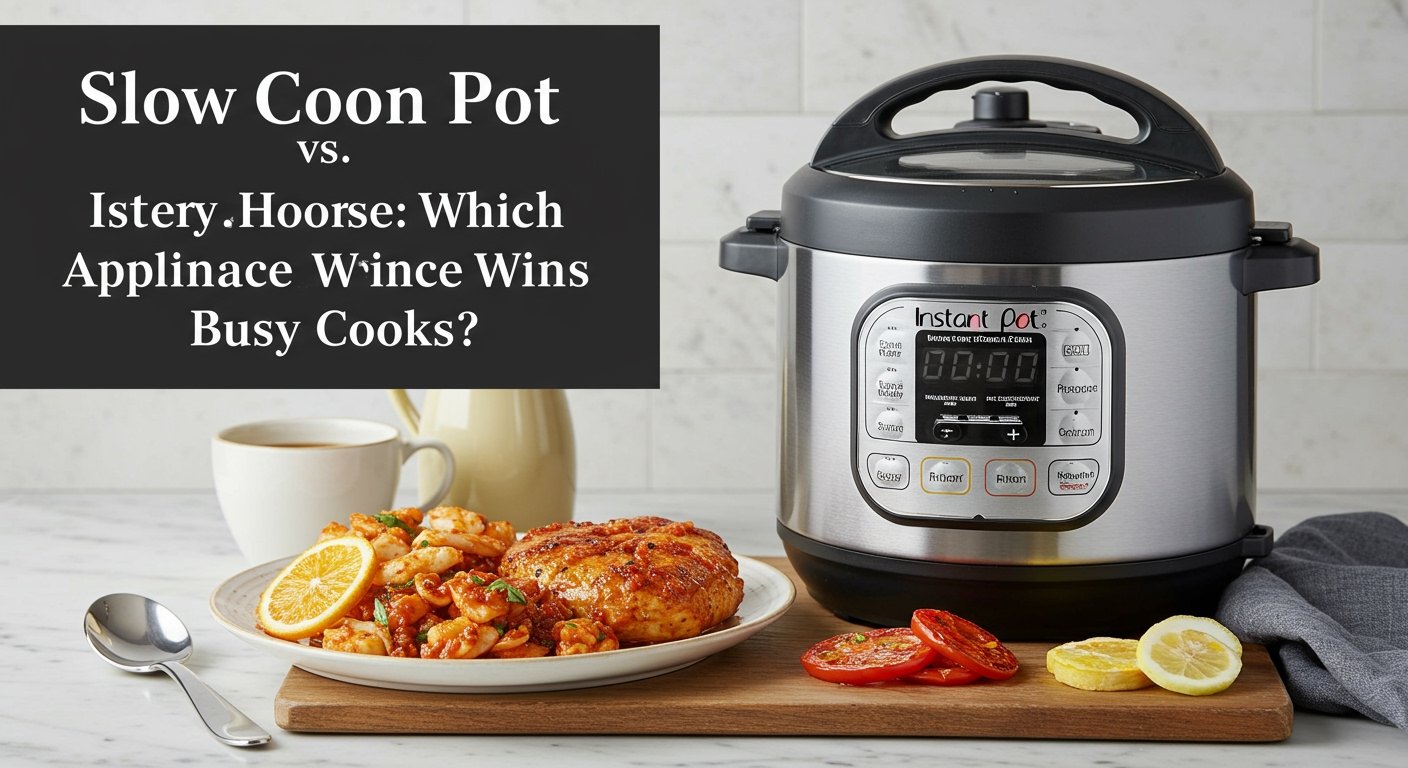In today’s fast-paced world, busy cooks are constantly searching for kitchen appliances that save time without sacrificing the quality of their meals. Two popular contenders often go head-to-head in this culinary arena: the slow cooker and the Instant Pot. Both promise convenience, but they achieve it in very different ways. For many households and working professionals, the U.S. slow cooker market continues to see increasing demand for time-saving kitchen appliances as of 2024, yet the multi-functional Instant Pot has surged in popularity, making the decision between the two a real dilemma. This article will help you understand the key differences between these appliances, weigh their pros and cons, and ultimately decide which one is the best fit for your busy lifestyle.
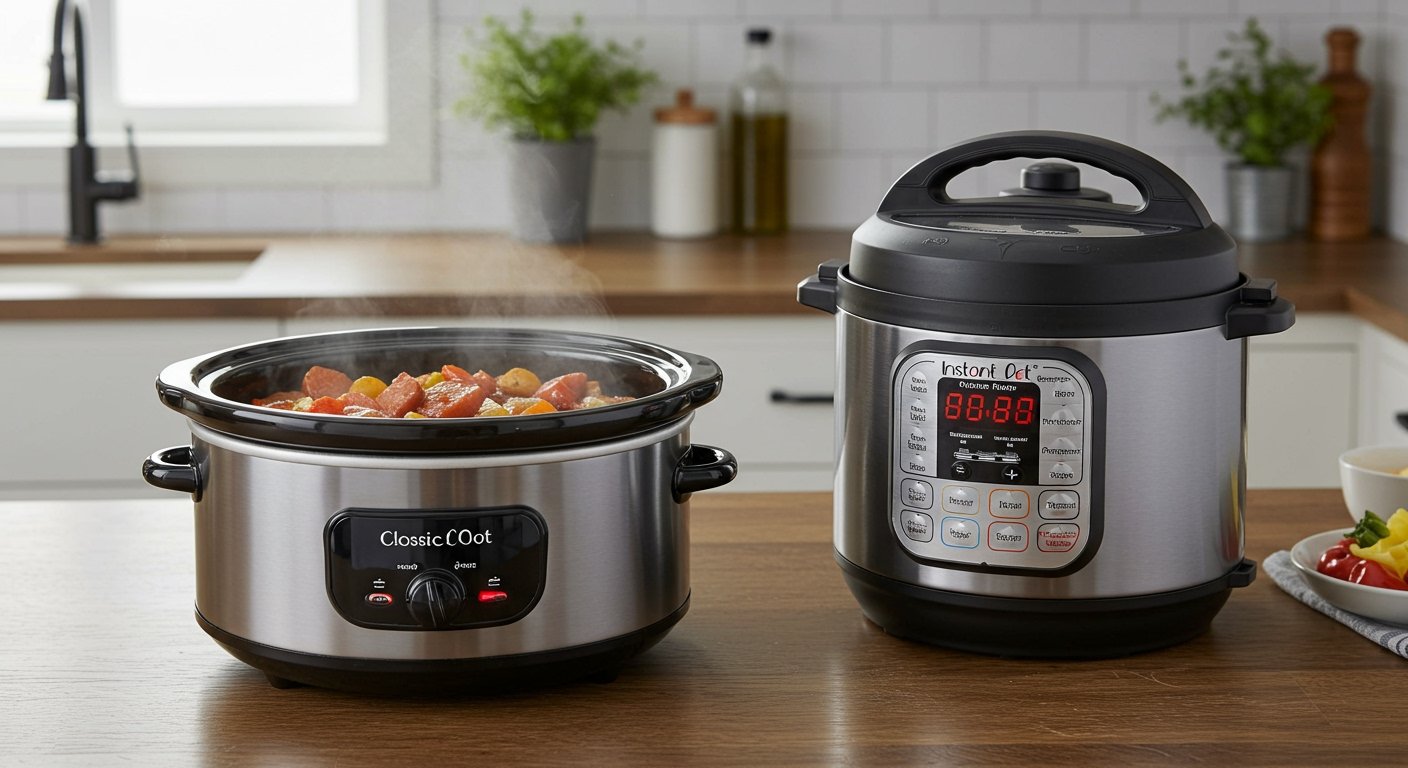
The Classic Comfort of the Slow Cooker
The slow cooker, often generically referred to as a Crock-Pot (after a popular brand), is a countertop electrical appliance designed to cook food at low temperatures over an extended period. Its simplicity is its charm: you add ingredients in the morning, turn it on, and come home to a ready-made meal. The concept of slow cooking has a rich history, with similar methods dating back centuries, but the modern slow cooker gained popularity in the United States during the 1940s as more women entered the workforce, needing a convenient way to prepare meals [1, 13].
Slow Cooker Benefits for Busy Families
Slow cookers offer several distinct advantages, especially for busy families and individuals looking for “set it and forget it” convenience:
- Effortless Meal Preparation: The primary benefit is minimal hands-on time. Simply combine your ingredients, set the timer, and let the appliance do the work. This makes it perfect for hearty stews, chili, pulled pork, and other slow cooker recipes for quick meals.
- Economical: Slow cooking can tenderize less expensive cuts of meat, turning them into flavorful, fall-apart dishes, which can lead to significant savings on your grocery bill.
- Delicious Results: The extended cooking time allows flavors to meld beautifully, creating rich, deep tastes that are hard to replicate with faster methods. It’s also excellent for cooking large batches, ideal for meal prep beginners or those looking for easy weeknight dinners slow cooker instant pot style.
- Energy Efficiency: Compared to a conventional oven, slow cookers use less electricity, and they don’t heat up your kitchen, making them a good option year-round [2, 10].
What are the Disadvantages of a Slow Cooker?
While slow cookers are fantastic for convenience, they do have a few drawbacks:
- Long Cooking Times: As the name suggests, slow cookers are… slow. Most recipes require 4-8 hours on high or 6-10 hours on low. This means you need to plan far in advance.
- Limited Functions: A traditional slow cooker typically only offers low and high heat settings and sometimes a ‘warm’ function. It’s a one-trick pony, albeit a very good one.
- Food Safety Concerns if Used Incorrectly: It’s crucial to follow food safety guidelines when using a slow cooker. Always ensure perishable foods are refrigerated until cooking time and thaw frozen meats completely before adding them. Large cuts of meat should also be cut into smaller pieces to ensure thorough cooking 2, 5]. For more information on safe cooking practices, refer to the [USDA’s guidelines on slow cooker food safety. [2]
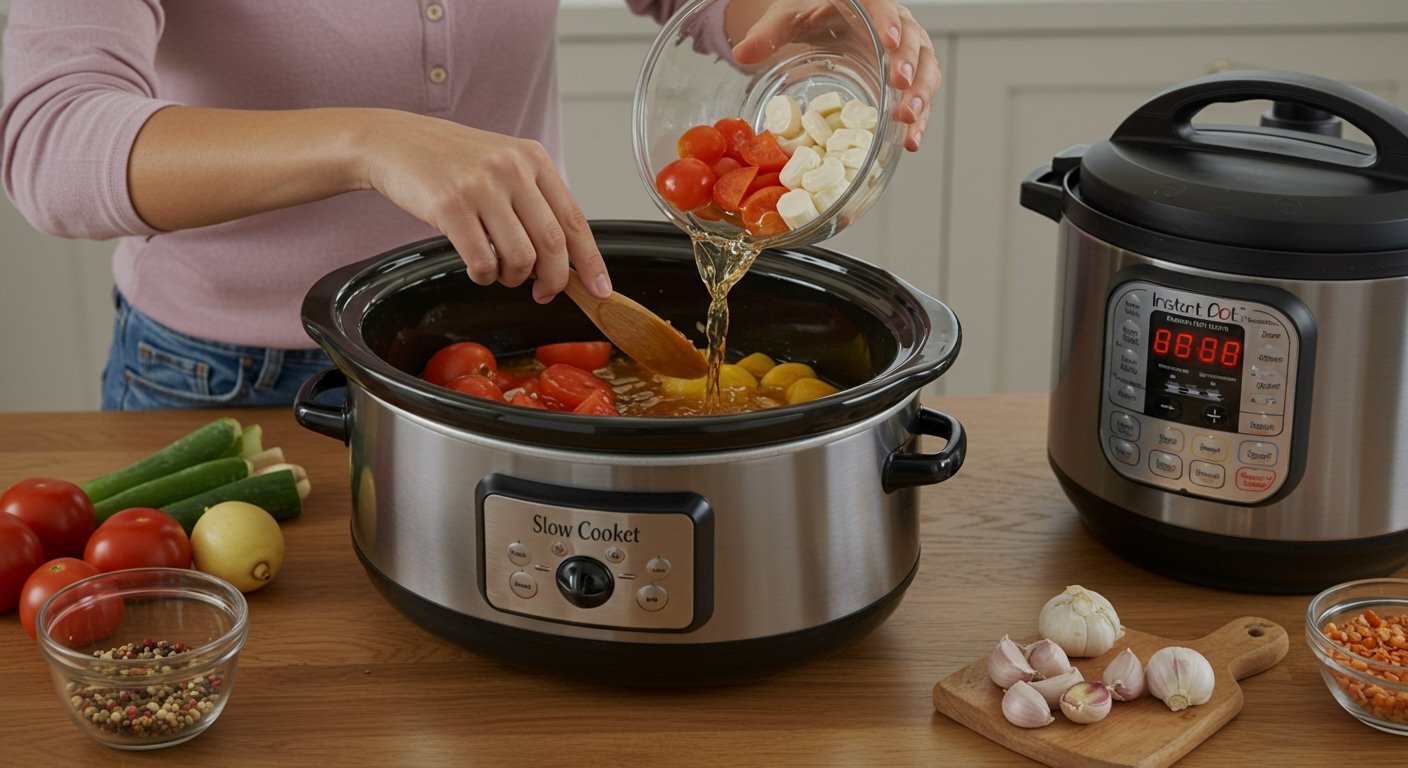
Introducing the Instant Pot: More Than Just a Pressure Cooker
The Instant Pot is a modern marvel in the kitchen appliance world. Developed by Robert Wang and his team in 2009, it quickly became a sensation for its versatility [11, 12]. It’s a multi-cooker that combines numerous appliances into one, most notably a pressure cooker, slow cooker, rice cooker, steamer, and sauté pan. This multi-functionality is a game-changer for many home cooks.
Instant Pot Pros and Cons
Let’s break down the advantages and disadvantages of this popular kitchen gadget:
#### Instant Pot Pros:
- Speed: This is where the Instant Pot truly shines. As a pressure cooker, it drastically reduces cooking times. The Instant Pot Mini, for example, is likely to reduce overall cooking time by 50% compared to conventional cooking methods. More than 85% of mini Instant Pot model users recommend it for convenience, proving its value to busy individuals.
- Multi-Functionality: It can sauté, steam, pressure cook, slow cook, make yogurt, and more. This means fewer single-purpose appliances cluttering your counter, addressing the need for space saving kitchen appliances. This versatility is a major factor in its popularity; as of July 2025, the Instant Pot Duo 7-in-1 Electric Pressure Cooker was the top-selling “crock pot” on Amazon, significantly outperforming traditional slow cookers due to its multi-functionality [4].
- Energy Efficiency: For optimum energy savings, Instant Pot energy efficiency wins over traditional Crock-Pot slow cookers, as it uses less power, less water, and radiates less heat into the home, particularly for quick meals.
- Nutrient Retention: Pressure cooking retains more nutrients than other cooking methods like boiling, as food cooks faster and less liquid is used, keeping vitamins and minerals locked in. [8, 19]
- Easy Cleanup: Many models feature a stainless steel inner pot that is dishwasher safe, and because it’s often a one-pot meal solution, cleanup is generally simpler.
#### Instant Pot Cons:
- Learning Curve: The Instant Pot can be intimidating at first with its many buttons and functions. Mastering pressure cooking requires understanding how to achieve and release pressure safely.
- Initial Cost: Instant Pots typically have a higher upfront cost than basic slow cookers.
- Pressure Release Time: While cooking time is fast, you still need to account for the time it takes for the pot to come to pressure and for the pressure to release, which can add 10-20 minutes or more to your total cooking time.
Is an Instant Pot Worth It for Working Parents?
For working parents, an Instant Pot can be an absolute game-changer. The ability to cook meals in a fraction of the time means less stress during hectic weeknights. Imagine getting home from work and having a delicious, homemade meal ready in 30 minutes instead of hours. Its versatility also means you can prepare a variety of healthy meals quickly, making it easier to avoid takeout. For anyone looking for essential kitchen gadgets for aspiring chefs or busy home cooks, the Instant Pot is a strong contender due to its time-saving capabilities.
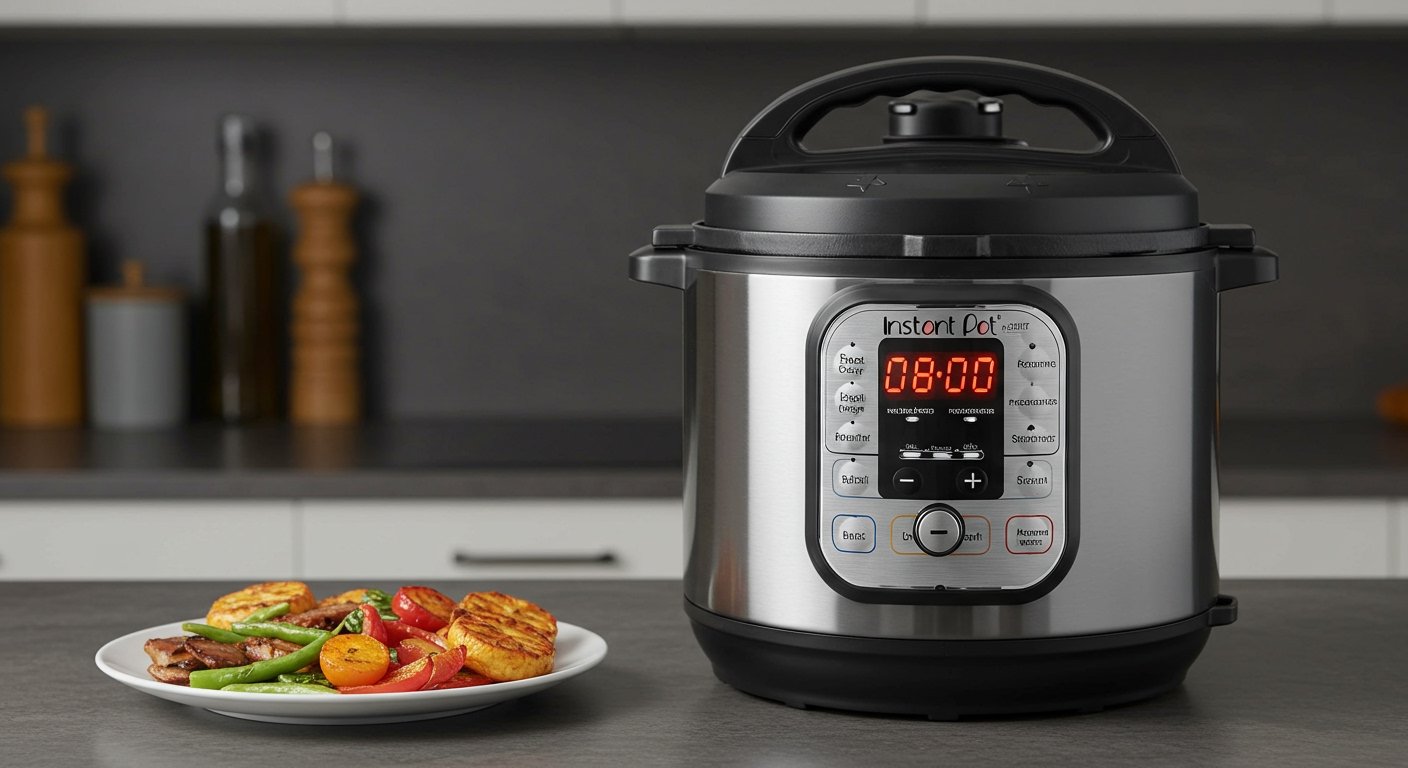
Slow Cooker vs. Instant Pot: Key Differences
When comparing the Instant Pot vs slow cooker differences, it largely boils down to speed, functionality, and cooking approach.
Which is Faster Instant Pot or Slow Cooker?
Undoubtedly, the Instant Pot is significantly faster, especially when using its pressure cooking function. A dish that takes 6-8 hours in a slow cooker might be ready in 30-60 minutes in an Instant Pot (plus pressure build-up and release time). This difference in Instant Pot cooking time vs slow cooker is the most compelling reason for many to choose the multi-cooker.
Instant Pot Functions vs Slow Cooker Functions
A traditional slow cooker typically has two heat settings (low/high) and a warm function. The Instant Pot, on the other hand, is a multi-cooker with numerous presets for pressure cooking, slow cooking, sautéing, steaming, rice cooking, yogurt making, and more. This makes the Instant Pot a more versatile appliance for a wider range of cooking tasks.
Cost of Instant Pot vs Slow Cooker
Generally, a basic slow cooker is more affordable, often ranging from $30-$70. Instant Pots, being multi-functional, usually cost more, typically between $80-$200, depending on the model and features. While the initial investment is higher, many consider the Instant Pot’s versatility to justify the cost, as it can replace several other kitchen appliances.
Space-Saving Kitchen Appliances
For those with limited kitchen counter or storage space, the Instant Pot’s ability to combine multiple functions into one appliance makes it a fantastic space-saving kitchen appliance. Instead of a slow cooker, a rice cooker, and a steamer, you just need one Instant Pot.
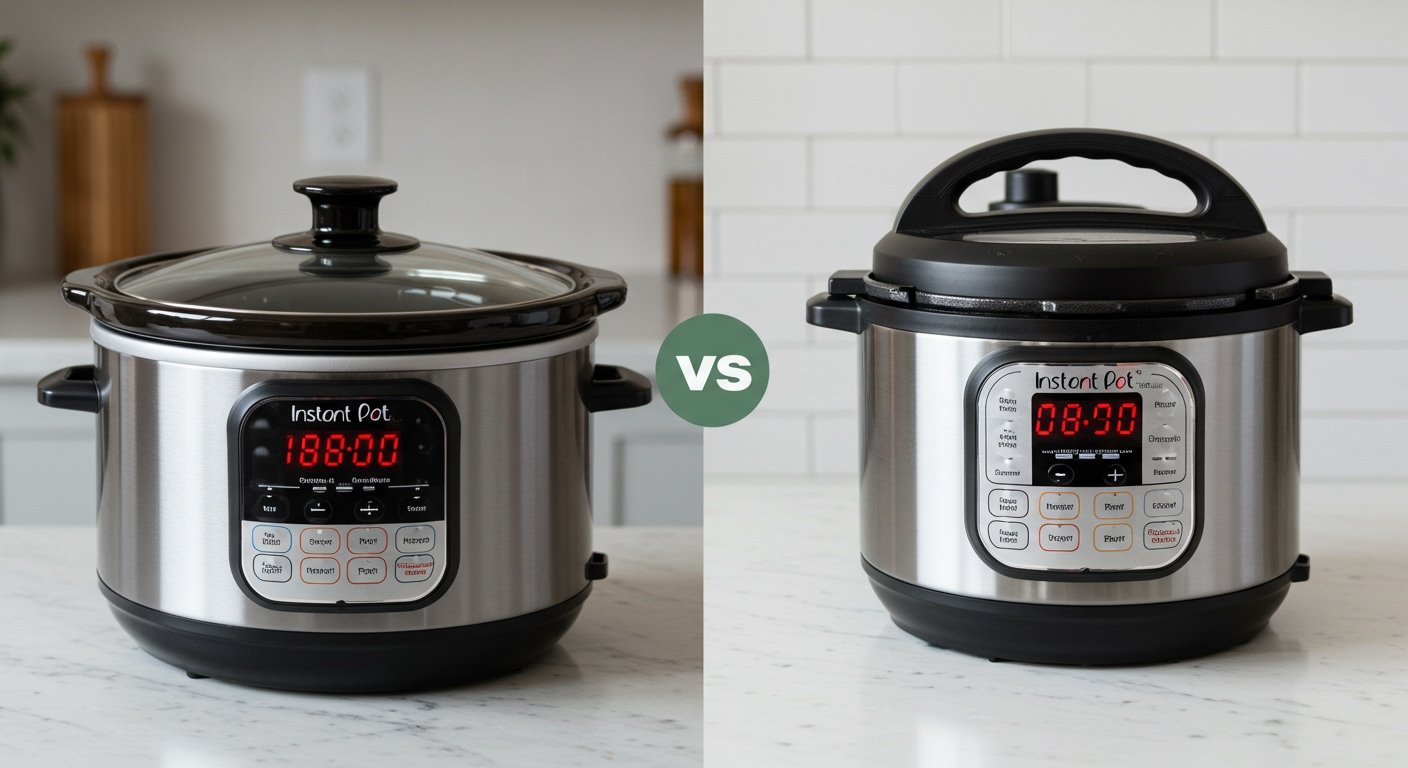
Which Appliance Wins for Busy Cooks? Slow Cooker vs. Instant Pot
So, which is better: Slow Cooker or Instant Pot? The ‘winner’ truly depends on your specific needs and cooking style.
Can an Instant Pot Replace a Slow Cooker?
Yes, an Instant Pot *can* replace a slow cooker, as most models include a slow cook function. However, purists argue that the slow cook function on an Instant Pot doesn’t always replicate the exact results of a dedicated slow cooker, sometimes cooking hotter or less evenly. For casual slow cooking, it’s generally sufficient, but if slow cooking is your absolute priority, a dedicated appliance might still be preferred.
Why is a Slow Cooker Better Than a Pressure Cooker? (And Vice-Versa)
This question highlights the core difference. A slow cooker excels when you want to develop deep, rich flavors over many hours, requiring almost no supervision. It’s ideal for tougher cuts of meat that benefit from long, moist heat, resulting in incredibly tender dishes. The beauty of a slow cooker lies in its ability to transform simple ingredients into comforting meals while you’re away. [6, 7]
A pressure cooker (which the Instant Pot primarily is) is better for speed. It’s fantastic for quickly cooking grains, beans, tough meats, and even making cheesecakes. Pressure cooking locks in moisture and nutrients more effectively than traditional boiling, and its rapid cooking can significantly reduce meal preparation time. [8, 17]
Ultimately, neither is definitively ‘better’ in all scenarios. It’s about what you prioritize: convenience and long, slow flavor development (slow cooker) or speed and versatility (Instant Pot).
Easy Weeknight Dinners: Slow Cooker Instant Pot Recipes & Meal Prep
Both appliances are fantastic tools for simplifying meal prep and creating easy weeknight dinners. Many recipes can be adapted for either, offering flexibility for your schedule. For example, a beef stew or chicken curry can be a slow cooker classic, simmering all day for a tender, flavorful result. The same dishes can be made in an Instant Pot in under an hour for a quick, post-work meal.
- Slow Cooker Meal Prep: Prepare ingredients the night before, load them into your slow cooker in the morning, and return home to a hot dinner. Think soups, stews, pulled chicken, or roasts.
- Instant Pot Meal Prep: Use the speed of the Instant Pot to cook components for meals in bulk. Cook a large batch of rice, quinoa, or beans in minutes. Quickly steam vegetables or cook chicken breasts to shred for various meals throughout the week. This makes it a best appliance for meal prep.
For more ideas on organizing your kitchen and simplifying cooking, check out our ultimate guide to meal prepping for beginners. If you’re looking for quick meal inspiration, our article on 25 easy weeknight dinners under 30 minutes offers plenty of ideas that can often be adapted for the Instant Pot’s speed.
Key Takeaways
- The **slow cooker** offers unparalleled convenience for long, slow cooking, ideal for tenderizing meats and developing deep flavors with minimal supervision.
- The **Instant Pot** is a highly versatile multi-cooker, excelling in speed and offering functions like pressure cooking, sautéing, and steaming, in addition to slow cooking.
- **Speed** is the Instant Pot’s main advantage, significantly reducing cooking times compared to a slow cooker.
- The **cost of Instant Pot vs slow cooker** is generally higher for the Instant Pot, but its multi-functionality can justify the investment by replacing several other appliances.
- For **busy cooks and working parents**, the Instant Pot often wins for its ability to deliver quick, healthy meals on tight schedules, although the slow cooker remains a beloved tool for passive cooking.
